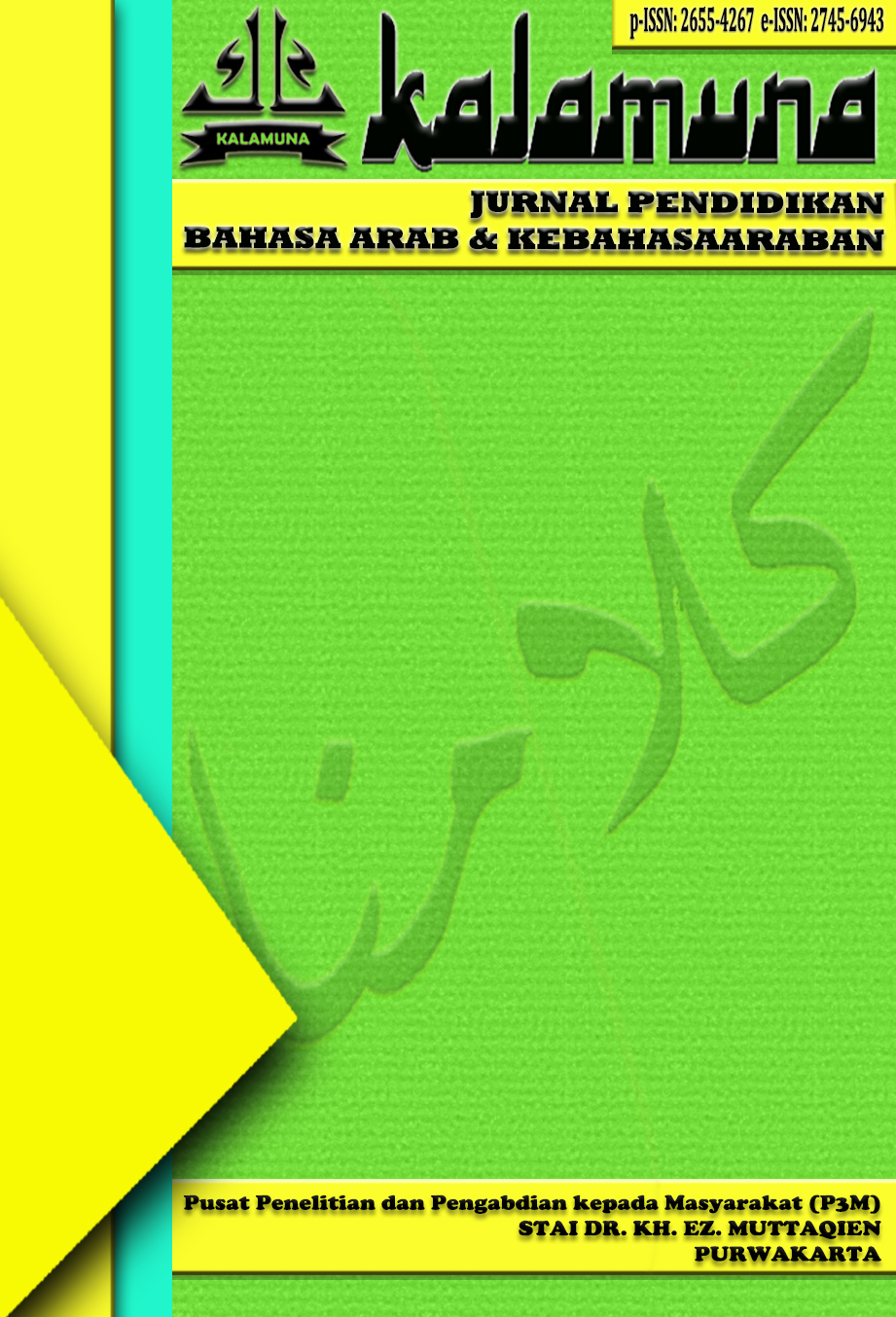Mimicry-Memorization Method: Elevating Arabic Speaking Skills with Visual Media
Keywords:
Mimicry-Memorization, Arabic, speaking ability, visual mediaAbstract
This research aims to explore the effectiveness of implementing the Mim-Mem (Mimicry-Memorization) Method with the support of visual media in enhancing Arabic speaking proficiency in a school environment. The Mim-Mem Method combines mimicry for better understanding and memorization for vocabulary reinforcement, while visual media is utilized as a clear representation of the learning material. The research methodology employed is classroom action research with students from grade XI A at SMP IT Sahabat Alam Pelabuhan Ratu Sukabumi as the subjects. Data were collected through observations, tests, and field notes over two research cycles. The results were analyzed to measure the improvement in students' speaking abilities. The research findings demonstrate a significant enhancement in students' speaking skills after applying the Mim-Mem Method with visual media. The average scores increased from 64 in the pre-test to 81 in the post-test, indicating the effectiveness of this method as a learning approach. The discussion involves in-depth analysis regarding the positive impact of the Mim-Mem Method with visual media on Arabic speaking skills among students. The novelty of this research lies in the innovative combination of methods with a visual approach, providing an effective solution to learning challenges. In conclusion, the implementation of the Mim-Mem Method with visual media makes a positive contribution to improving Arabic speaking skills among students at SMP IT Sahabat Alam Pelabuhan Ratu Sukabumi. Recommendations for future research could focus on further developing this method, including variations in teaching approaches and more specific adjustments to students' characteristics. Additionally, further studies could explore the effectiveness of this method in higher education contexts or different educational environments.
References
Aini, S., & Wijaya, M. (2018). The Mimicry-Memorization Method (Mim-Mem Method) in Improving Students’ Mufrodat Mastery in Madrasahs. PALAPA, 6(1), 90–110. https://doi.org/10.36088/palapa.v6i1.61
Aisa, A., & Fikrotin, V. (2022). MIM-MEM METHOD IN LEARNING ARABIC.
Arifin, Z., Bakar, N. K. A., Ridzwan, Z., & Jamsari, E. A. (2021). Language Learning Strategies of Non-Muslim Students Applied to Arabic Language Course Inside and Outside the Classroom. Ijaz Arabi Journal Of Arabic Learning, 4(1).
Baroroh, R. U., & Rahmawati, F. N. (2020). Metode-metode dalam pembelajaran keterampilan bahasa Arab reseptif. Urwatul
Wutsqo: Jurnal Studi Kependidikan Dan Keislaman, 9(2), 179–196.
bin Samah, R., Puteh-Behak, F., Saad, N. S. M., Ali, S. M., Darmi, R., & Harun, H. (2016). Effective methods in learning Arabic language as a foreign language. Mediterranean Journal of Social Sciences.
Blake, R. J., & Shiri, S. (2012). Online Arabic language learning: What happens after? L2 Journal, 4(2).
Brosh, H. Y. (2019). Arabic language-learning strategy preferences among undergraduate students. Studies in Second Language Learning and Teaching, 9(2), 351–377.
Dahlan, J. (1992). Metode Belajar Mengajar Bahasa Arab. Surabaya: Al-Ikhlas.
Fatati, A., & Sutarjo, J. (2021). IMPLEMENTATION OF THE MIMICRY MEMORIZATION (MIM-MEM) METHOD IN MUFRODAT LEARNING. 23(1).
Fauzi, M. F., & Anindiati, I. (2021). Improving the Motivation of Students in Arabic Language Learning through Learning Management System. Izdihar: Journal of Arabic Language Teaching, Linguistics, and Literature, 4(3), 257–274.
Hikmah, D., Petoukhoff, G., & Papaioannou, J. (2022). The Utilization of the Animiz Application as a Media for Arabic Language Learning on Students. JILTECH: Journal International of Lingua & Technology, 1(2).
Hilmi, D., & Ifawati, N. I. (2020). Using the blended learning as an alternative model of Arabic language learning in the pandemic era. Arabi: Journal of Arabic Studies, 5(2), 117–129.
Iqbal, M. (2018). Penggunaan Metode Mim-Mem Untuk Mengembangkan Keterampilan Berbicara. Al Mi’yar: Jurnal Ilmiah Pembelajaran Bahasa Arab Dan Kebahasaaraban, 1(2), 113–130.
Juryatina, J., & Amrin, A. (2021). Students’ interest in Arabic language learning: the roles of teacher. Journal of Educational Management and Instruction (JEMIN), 1(1), 40–49.
Lune, H., & Berg, B. L. (2017). Qualitative research methods for the social sciences. Pearson.
Marissa, K. R. (2022). Analisis Metode Mim-Mem (MIMICRY-MEMORIZATION) Pada Pembelajaran Bahasa Arab Di Madrasah Tsanawiyah Negeri 4 Tanjung Jabung Timur. Jurnal Pendidikan Bahasa Arab Dan Budaya Islam, 3(01), 59–67.
Maxwell, J. A. (2008). Designing a qualitative study. The SAGE Handbook of Applied Social Research Methods, 2, 214–253.
Miavara, H. M., Safitri, W., & Arifin, M. M. (2022). Penggunaan Metode Mimicry Memorization Dalam Penguasaan Mufradat Siswa Kelas VIII B SMP Muhammadiyah Haurgeulis. PUSTAKA: Jurnal Bahasa Dan Pendidikan, 2(4), 102–113.
Muslim, B. (2022). The Arabic Language Contribution to the IstinbÄt in Islamic Law of Acehnese Scholars. Samarah, 6(1), 224–243. https://doi.org/10.22373/SJHK.V6I1.11732
Retnawati, H., Rahmatullah, S., Djidu, H., & Apino, E. (2020). Has Arabic Language Learning Been Successfully Implemented?. International Journal of Instruction, 13(4), 715–730.
Ritonga, M., Widayanti, R., Alrasi, F., & Halim, S. (2020). Analysis of Arabic language learning at higher education institutions with multi-religion students.
Rosyidi, A. W. (2009). Media pembelajaran bahasa Arab. UIN-Maliki Press.
Skinner, B. F. (2019). The behavior of organisms: An experimental analysis. BF Skinner Foundation.
Wahba, K. M., & Chaker, A. Q. (2013). Arabic language learning textbooks: an evaluation of current approaches. Al-’Arabiyya, 111–123.
Wargadinata, W., Maimunah, I., Febriani, S. R., & Pimada, L. H. (2020). Mediated Arabic language learning for Arabic students of higher education in COVID-19 situation. Izdihar: Journal of Arabic Language Teaching, Linguistics, and Literature, 3(1), 1–18.
Yusuf, M., & Wekke, I. S. (2018). Bahasa Arab Bahasa Alquran. Deepublish.













